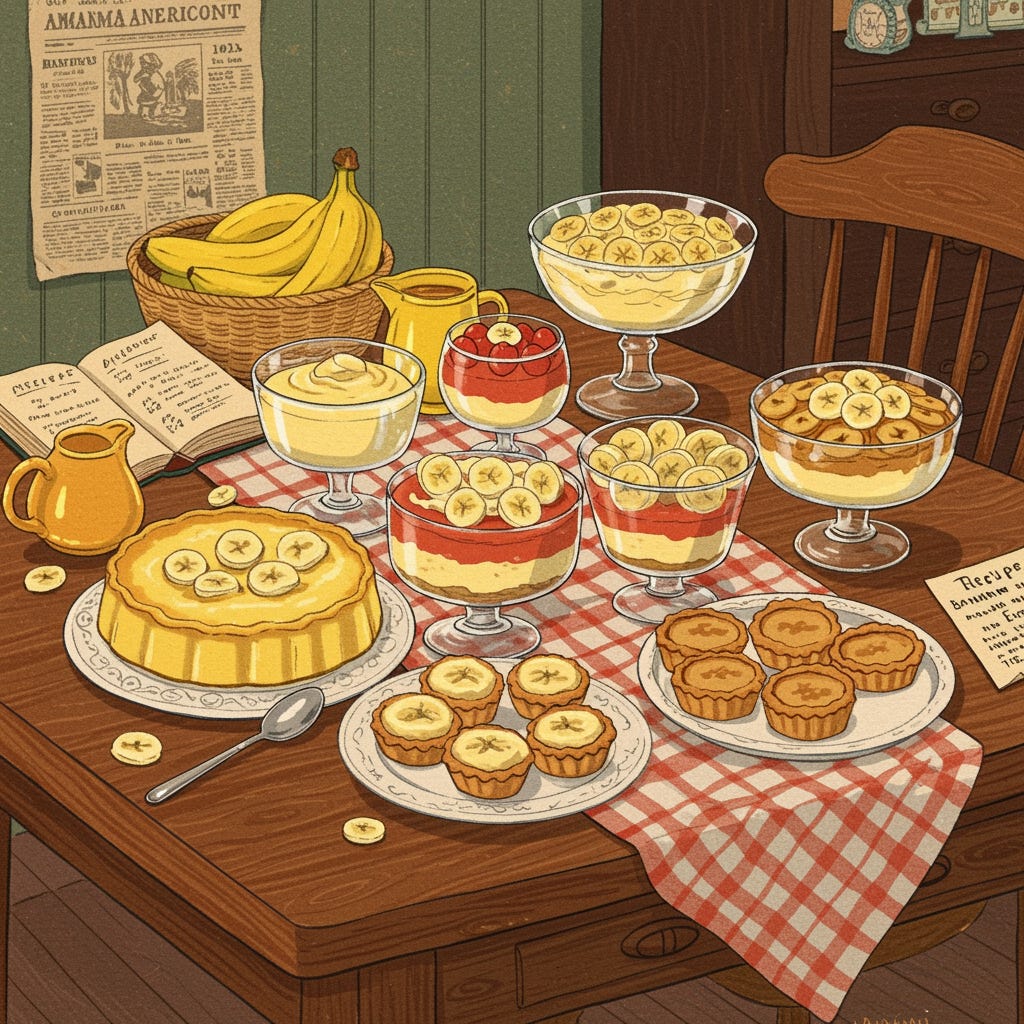The Banana: A Versatile Food Fruit Rediscovered
In the early 20th century, the banana emerged as a novel and versatile ingredient in American kitchens, celebrated for its nutritional value and culinary adaptability. A 1913 article from the Manchester Democrat, published in Manchester, Iowa, reflects this growing fascination with the tropical fruit, offering readers practical recipes and emphasizing its role in diversifying the domestic menu.1 At a time when bananas were becoming more accessible due to advancements in transportation and trade, such articles helped demystify the fruit for rural American households, encouraging its integration into everyday meals. This historic piece not only showcases the banana’s culinary potential but also provides a glimpse into the evolving food culture of the era, where exotic ingredients began to find a place alongside traditional staples. Below is a full transcript of the article, preserving its original language and structure.
BANANA A FOOD FRUIT
IT’S NUTRITIVE VALUE IS NOT SUFFICIENTLY APPRECIATED.
Either by Itself of Mingled With Other Comestibles It Gives Variety to the Domestic Menu—Some Hints Worth Heeding.
The banana is certainly a food fruit, and contains, in a agreeable form, all the essential elements of nutrition. It gives, moreover, a variety to the domestic menu and mingles well with other comestibles. It is excellent eaten raw, but must be quite ripe, and that is only when every trace of green has disappeared.
By way of variety, a few recipes are appended. These are all delicious and are bound to be appreciated:
Banana Custard.—Peel six bananas and pass through a sieve; add two tablespoons of sugar, four well-beaten eggs, two cupfuls of milk and one teaspoonful of lemon extract; pour into a buttered fireproof dish and bake till set in a moderate oven. When cold ornament with cherries cut in halves.
Banana Salad.—Select large ripe bananas, one for each person; peel and place on a lettuce leaf. Cover with a good mayonnaise sauce and sprinkle with chopped English walnut meats, and serve at once.
Another method is to add one tablespoonful of olive oil by degrees to an equal quantity of vinegar, mixing carefully; then add one teaspoonful of sugar. Peel three ripe bananas, and slice them across in equal slices of medium thickness; place in the salad bowl and pour the dressing over. Dust with white pepper and salt.
Banana Charlotte.—Line the bottom of a plain mold with a layer of lemon jelly and decorate with stripes of neatly cut angelica and candied cherries. Trim the required number of lady fingers and line the sides of the mold so that they fit closely. Beat up three eggs in a basin and stir in two cupfuls of boiling milk, sweetened with three tablespoonfuls of sugar. Return this to the saucepan, add one heaping tablespoonful of powdered gelatin which has been dissolved in half a cupful of boiling water, one teaspoonful of vanilla extract, and stir over the fire with a wooden spoon until it thickens. Remove from the fire , add the pulp of four ripe bananas and when cool fold in one cupful of whipped cream. Just before the mixture sets pour it into the prepared mold and place it on ice to firm. Unmold the shape carefully on to a cold dish and serve.
Banana Tartlets.—Soak eight tablespoonfuls of chopped cocoanut in sufficient milk to cover, beat up till smooth and the thickness of batter, then add three tablespoonfuls of melted butter, four beaten yolks of eggs, half a cupful of whipped cream, one teaspoonful of vanilla extract and the stiffly beaten whites of two eggs. Peel 12 bananas and rub them through a sieve, then add them to mixture. Line gem pans with pastry and fill with the mixture; bake in a hot oven for ten minutes. Beat up the whites of two eggs until stiff, then add half a pound of confectioners’ sugar and one tablespoonful of cornstarch, and mix well together. Put a thin layer over the tartlets and put them in the over to dry.
Manchester Democrat (Manchester, Iowa), 26 Feb. 1913. Chronicling America: Historic American Newspapers. Lib. of Congress. https://chroniclingamerica.loc.gov/lccn/sn84038306/1913-02-26/ed-1/seq-3/




